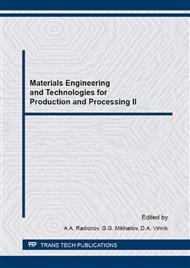[1]
R.L. Plaut, A.F. Padilha, N.B. Lima, C. Herrera, A.F. Filho, L.H. Yoshimura, Medium carbon steel deep drawing: A study on the evolution of mechanical properties, texture and simulations, from cold rolling to the end product, Material Science and Engineering A. 499 (2009).
DOI: 10.1016/j.msea.2007.11.131
Google Scholar
[2]
F. Fang, X. Hu, B. Zhang, Z. Xie, J. Jiang, Deformation of dual-structure medium carbon steel in cold drawing, Material Science & Engineering A. 583 (2013) 78-83.
DOI: 10.1016/j.msea.2013.06.081
Google Scholar
[3]
Y.S. Yang, J.G. Bae, C.G. Park, Nanostructure and mechanical properties of heavily cold-drawn steel wires, Materials Science and Engineering A. 508 (2009) 148-155.
DOI: 10.1016/j.msea.2008.12.036
Google Scholar
[4]
Y.G. Ko, S. Namgung, D.H. Shin, I.H. Son, K.H. Rhee, D. Lee, Spheriodization of medium carbon steel fabricated by continuous share drawing, J Mater Sci. 45 (2010) 4866-4870.
DOI: 10.1007/s10853-010-4587-0
Google Scholar
[5]
K. Muszka, L. Madej, J. Majta, The effects of deformation and microstructure inhomogeneities in the accumulative angular drawing (ADD), Materials Science & Engineering A. 574 (2013) 68-74.
DOI: 10.1016/j.msea.2013.03.024
Google Scholar
[6]
A. Volokitin, A. Naizabekov, S. Lezhnev, Research of a new method of deformation – Pressing – Drawing, on mechanical properties of steel wire, METAL 2013 – Int. Conf. Metall. Mater. (2013) 376-379.
Google Scholar
[7]
N. Pholdee, H. M. Baek, S. Bureerat, Y. Im, Process optimization of a non-circular drawing sequence based on multi-surrogate assisted meta-heuristic algorithms, Journal of mechanical Science and Technology. 29 (2015) 3427-3436.
DOI: 10.1007/s12206-015-0741-6
Google Scholar
[8]
W.Z. Misiolek, Modelling of microstructure response to deformation parameters in selected metal forming processes, Spec. Ed.: Int. Conf. Technol, Plast. (2011) 56-62.
Google Scholar
[9]
P. Houtte, G.J. Sevillarno, E. Aernoudt, Models for shear band formation in rolling and extrusion, Z Metallkd. 70 (1979) 426-432.
DOI: 10.1515/ijmr-1979-700703
Google Scholar
[10]
R. Kruzel, M. Suliga, The effect of multiple bending on wire on the residual stresses of high carbon steel wires, Matellurgia. 52 (2013) 93-95.
Google Scholar
[11]
C. Cordier-Robert, B. Forfert, B. Bolle, J. Fundenberger, A. Tidu, Influence of torsion deformation on microstructure of cold-drawn pearlitic steel wire, J Mater Sci. 43 (2008) 1241-1248.
DOI: 10.1007/s10853-007-2272-8
Google Scholar
[12]
N. Guo, B. Song, B. Wang, Q. Liu, Influence of torsion deformation on textures of cold drawing pearlitic steel wires, Acta Metall. Sin. (Engl. Lett. ). 28 (2015) 707-714.
DOI: 10.1007/s40195-015-0251-7
Google Scholar
[13]
B. Goes, A. Martin-Miezoso, J. Gil-Sevillano, I. Lefever, E. Aernoudt, Fragmentation of as-drawn pearlitic steel wires during torsion tests, Engineering Fracture Mechanics. 60 (1998) 255-272.
DOI: 10.1016/s0013-7944(98)00023-x
Google Scholar
[14]
P. Funke, Chr. Pavlidis, I. Piorko, Continuous cross section reductions a result of combined bending and drawing: effect on the strength characteristics of a special deep drawing steel, DFBO Mitt. 24 (1973) 154-159.
Google Scholar
[15]
I. Saunders, J. Nutting, Deformation of Metals to high strains using combination of torsion and compression, Metal Science. 18 (1984) 571-575.
DOI: 10.1179/030634584790419629
Google Scholar
[16]
A. Korchunov, M. Chukin, G. Gun, G. Rubin, M. Polyakova, D. Dolgy, Characteristics of deformation processing of high-strength reinforcement for the new generation reinforced concrete ties, Bulletin of the South Ural State University. 36 (2011).
Google Scholar
[17]
M. Polyakova, A. Gulin, D. Constantinov, Investigation of microstructure and mechanical properties of carbon steel wire after continuous method of deformational nanostructuring, Applied Mechanics and Materials. 436 (2013) 114-120.
DOI: 10.4028/www.scientific.net/amm.436.114
Google Scholar
[18]
M. Chukin, M. Polyakova, A. Gulin, O. Nikitenko, The possibility of manufacturing long-length metal products with ultra-fine grain structure by combination of strain effects, Key Engineering Materials. 685 (2015) 487-491.
DOI: 10.4028/www.scientific.net/kem.685.487
Google Scholar
[19]
M. Chukin, M. Polyakova, E. Golubchik, V. Rudakov, S. Noskov, A. Gulin, R.U. Patent 2, 467, 816. (2012).
Google Scholar
[20]
M. Polyakova, M. Chukin, E. Golubchik, A. Gulin, R.U. Patent 130, 525. (2013).
Google Scholar
[21]
E. Golubchik, M. Polyakova, A. Gulin, Adaptive approach to quality management in combined methods of material processing, Applied Mechanics and Materials. 656 (2014) 497-506.
DOI: 10.4028/www.scientific.net/amm.656.497
Google Scholar
[22]
E. Golubchik, M. Polyakova, Adaptive approach to structure and properties forming in niobium alloyed pipe steels, Proceedings of the 2015 International Conference on Structural, Mechanical and Material Engineering, Ed. by Mohamed F. Eldessouki, Mobeh Kaloop. 19 (2015).
DOI: 10.2991/icsmme-15.2015.5
Google Scholar


